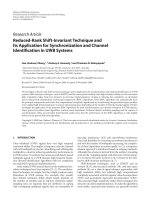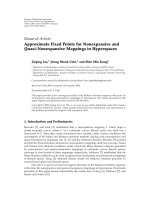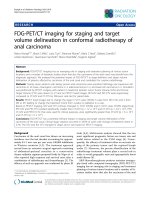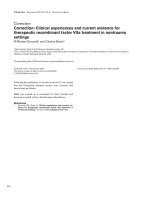Application For Bar-Coding And Rfid Course Ict In Freight Forwarding.pdf
Bạn đang xem bản rút gọn của tài liệu. Xem và tải ngay bản đầy đủ của tài liệu tại đây (2.8 MB, 17 trang )
<span class="text_page_counter">Trang 1</span><div class="page_container" data-page="1">
<b>MINISTRY OF TRANSPORTVIETNAM AVIATION ACADEMYFACULTY OF AVIATION ECONOMICS</b>
</div><span class="text_page_counter">Trang 2</span><div class="page_container" data-page="2"><b>NameStudents ID</b>
</div><span class="text_page_counter">Trang 3</span><div class="page_container" data-page="3"><b>1. What is barcoding and RFID?...</b>
1.2.3 Some usual barcode applications:...
<b>2. Application for bar-coding and RFID?...</b>
2.1 Introduction to Uniqlo:...
2.2 Application for RFID in Uniqlo:...
2.2.1 RFID Hang Tags:...
2.2.2 RFID Fitting Mirrors...
2.2.3 RFID Self-checkout...
2.3. Limitations of RFID when applying to Uniqlo:...
2.4 Application for barcoding in Uniqlo:...
</div><span class="text_page_counter">Trang 4</span><div class="page_container" data-page="4"><b>1. What is barcoding and RFID?1.1 What is RFID ? </b>
<b>1.1.1 Definition: </b>
RFID stands for Radio frequency identification. RFID is a form of wirelesscommunication that incorporates the use of electromagnetic or electrostatic couplingin the radio frequency portion of the electromagnetic spectrum to uniquely identify anobject, animal, or person (remote wireless connection).
<b>1.1.2 Types of RFID </b>
<b>Figure 1: types of RFID tags </b>
RFID tag is divided into 3 main types:
<b>1.1.2.1 Active tag RFID: </b>
RFID active tags have their own power source. The card is mainly used in theLogistics industry, automatic toll collection, smart parking... However, due to highcost, bulky design, and limited usage time, both types of cards are often not verypopular in practice.
<b>1.1.2.2 Passive tag RFID: </b>
Passive tags have no power source. Passive tags are compact, convenient, and cost, so they are widely used in identification solutions, security control, goodsmanagement, etc.
</div><span class="text_page_counter">Trang 5</span><div class="page_container" data-page="5"><b>low-1.1.2.3 Semi-passive tag RFID </b>
Semi-passive tags do not actively transmit radio signals to the reader, but instead liedormant and conserve energy until they receive a radio signal from the reader thatactivates the system. Semi-active RFID tags are faster in response and therefore morerobust in reading transmitted numbers than passive tags. Therefore its reading distanceis also farther than that of passive tags.
<b>1.1.3 Some usual RFID applications: </b>
- Traceability in the supply chain
- Logistics and inventory in the retail industry- Security control for jewelry and cosmetics- IT asset tracking
- Libraries- Files and archives- Tool tracking- Laundry management- Sports Timing
- Human traceability and access control in facilities- Traceability of animals
- Vehicle tracking
<b>1.2 What is barcoding?1.2.1 Definition: </b>
Barcoding is a printed series of parallel bars or lines of varying width that is used forentering data into a computer system. The bars are typically black on a whitebackground, and their width and quantity vary according to application. It's like aspecial code that stores information. For example, you've probably seen barcodes onproducts at the grocery store or on library books.
</div><span class="text_page_counter">Trang 6</span><div class="page_container" data-page="6"><b>1.2.2 Types of barcode:</b>
<b>Figure 2: Types of Barcode</b>
- Require as much as 80% contrast.
- Encode data on both the horizontal andvertical axes.
- High data capacity: Stores significantlymore information. A standard QR codecan hold up to 3,000 numbers or 7,000letters
- Can be read in low contrast.
</div><span class="text_page_counter">Trang 7</span><div class="page_container" data-page="7">- Alphanumeric characters.
- 1D barcodes are simpler and faster forbasic data.
- Imagine, website links and others.
- 2D barcodes offer more data storageand flexibility for complex applications.
<b>1.2.3 Some usual barcode applications: </b>
- Retail Revolution: The Fundamental Use of Barcodes- Healthcare: Enhancing Patient Safety and Data Accuracy- Library Logistics
- Manufacturing: Improving Production Efficiency- Logistics: Optimizing Supply Chain Management- Events: Streamlining Attendee Management
- Asset Accountability: Tracking Valuables with Precision- Smartphones: Barcodes in the Digital Era
In general, using RFID as an alternative to barcodes is increasing in use. RFID andbarcode technologies are used in similar ways to track inventory, but there are someimportant differences between them.
<b>2. Application for bar-coding and RFID? 2.1 Introduction to Uniqlo: </b>
UNIQLO is a clothing apparel company, which was originally founded in Yamaguchi,Japan in 1949 as a textiles manufacturer. Uniqlo is an international clothing retailerthat has a specialized knack for designing apparel that lasts. And now Uniqlo has beenestablished as a global brand with over 1000 stores around the world to redefiningclothing, with a focus on quality and textiles. This company was created with a uniquebusiness model called the SPA manufacturer retailer model. With this model, acompany controls the whole process of clothing retail product planning andproduction to distribution and marketing. For instance, it has basics-inspired clothingcreated at trend cycle after trend cycle, season after season.
</div><span class="text_page_counter">Trang 8</span><div class="page_container" data-page="8"><b>Figure 3: Uniqlo Figure 4: Uniqlo store </b>
<b>2.2 Application for RFID in Uniqlo: </b>
UNIQLO marked supply chain transformation since 2016 and has applied RFID since2017 in 3000 stores worldwide. In order to overcome such challenges from thesedigital giants, the company needs to transform our supply-chain system by usingdigital technologies.
<b>2.2.1 RFID Hang Tags:</b>
RFID hang tags are embedded with UHF RFID tags. Based on the size difference,Uniqlo uses a variety of tags and only three antennas as below:
<b> Figure 5: Slim UHF tags Figure 6: Omnidirectional RFID</b>
</div><span class="text_page_counter">Trang 9</span><div class="page_container" data-page="9"><b>Figure 7: Good Directional RFID</b>
<b>And to be more specific, Uniqlo uses 3 types of UHF tags: </b>
For retail stores, inventory management is the process of buying, manufacturing,storing, and using a company’s product. Taking control and tracking of enterprises’inventories requires a systematic and organized approach such as RFID technology.By hanging products with these RFID tags, items can be read through a nearby RFIDscanner in an appropriate and precise manner.
RFID stock control has three components: RFID tags, interrogators, and software tomanage the products in UNIQLO stores. By embedding RFID tags in products,logistics staff can read through RFID scanners without a line-of-sight feature. TheRFID interrogator is then further attached to the software to display product detailssuch as model or brand, size, shape, color, and price.
</div><span class="text_page_counter">Trang 10</span><div class="page_container" data-page="10">All the products in UNIQLO stores contain UHF RFID tags operating at 860-960MHz. However, the brand embraces multiple types of UHF RFID tags depending ontheir sizes to detect products wirelessly to cut down labor and inventory costs.
<b>2.2.2 RFID Fitting Mirrors</b>
UNIQLO RFID fitting mirrors let the customers check all the products present ontheir shelves, place orders with just one click, and they will have favorite items intheir hands. RFID fitting mirrors are valuable in making shopping guides. Similarly,customers just need to take a shirt, and then let the reader read RFID tags, we canchoose colors and sizes on the system and the product will be displayed on the mirror.
<b>2.2.3 RFID Self-checkout</b>
Figure 8: Self-checkout process for Uniqlo
The RFID self-checkout process is also present in UNIQLO stores. The product fromthe shopping cart is ready for the checking process. The system contains a smallmachine with a flat surface to scan the items. And how does it work?
</div><span class="text_page_counter">Trang 11</span><div class="page_container" data-page="11">- Customers will pick up each piece of clothing one by one and hold it close tothe scanner.
- The RFID tag on the clothing will receive a signal, prompting it to send backinformation about the cloth’s price and sizing to the scanner.
- The scanner then will display the details of the Uniqlo on a screen (name, size,color, price,...)
- The self-checkout counter processes the product by popping up billinginformation, allowing the customers to swipe the code to make a transactionand receive a receipt after that process. There are also guides for customers tomake payment easier.
<b>2.3. Advantages of RFID when applying to Uniqlo:</b>
From the above description, it shows that RFID technology is improving the UNIQLOshopping experience, inventory management, and checkout process. Since in all thesesteps, everything is automatic, and there exists no need for a cashier, or retailing staffto help the customers, enabling UNIQLO stores to reduce transaction time andcheckout process.
Uniqlo said that RFID has resulted in “a significant reduction in out-of-stock” itemson the sales floor and that it has contributed to “reducing lost opportunities andimproving customer satisfaction.” The company declined to provide more specificinformation regarding the business impact of the technology.
In contrast, sometimes, RFID still has some technical problems, especially when thereare too many items at the same time in the basket. The system may find it hard todistinguish them when they lie on each other.
</div><span class="text_page_counter">Trang 12</span><div class="page_container" data-page="12"><b>2.4 Application for barcoding in Uniqlo: </b>
<b>2.4.1.2 Point of Sale (POS) Systems: </b>
Barcodes are used to facilitate smooth and fast checkout processes. By scanningbarcodes, sales associates can quickly retrieve product information, including priceand stock availability, reducing the time customers spend at the checkout counter.
<b>2.4.1.3 Operational Efficiency: </b>
Barcoding streamlines various operational processes, such as receiving shipments,stock transfers between stores, and inventory audits. By scanning barcodes, employeescan quickly and accurately update inventory records, eliminating manual data entryand reducing the likelihood of errors.
<b>2.4.1.4 Customer Experience: </b>
Barcoding systems contribute to a smoother and more efficient shopping experiencefor customers. Accurate inventory tracking ensures that products are readily available,reducing instances of out-of-stock items. Additionally, faster checkout processesimprove customer satisfaction by minimizing wait times.
<b>2.4.2. How Uniqlo applies bar-coding2.4.2.1. Inventory Management</b>
The UPC barcode provides a unique identifier for each product. It allows Uniqlo todifferentiate and track individual items in its inventory system. The barcode containsinformation such as the product's manufacturer and specific item number.
</div><span class="text_page_counter">Trang 13</span><div class="page_container" data-page="13">Figure 9: Check for inventory at shops by scan barcodes
<b>2.4.2.2 Point of Sale (POS) Systems</b>
Scanning UPC barcodes at the point of sale speeds up the checkout process. It enablescashiers to quickly scan the barcodes on the products, automatically retrieving thecorresponding product information and pricing in the store's system. This reduceserrors and helps maintain a smooth and efficient customer experience.
By using UPC barcodes, Uniqlo can accurately track and manage its inventory. Eachtime a product is sold, the barcode is scanned, and the system updates the inventorylevels accordingly. This information helps Uniqlo optimize its stock, identify popularproducts, and facilitate restocking.
But in reality, POS is used just in some stores of Uniqlo not all of the stores becausethe stores are still in the transformation between the traditional cashier and cashierlessstores. For example, Uniqlo’s checkout machines are available in all 47 U.S. and 16Canadian stores, and 14 of the 25 markets where it has stores, the company said.Stores also offer cashier checkout.
</div><span class="text_page_counter">Trang 14</span><div class="page_container" data-page="14">Figure 10: UPC Barcode2.5 Limitation
<b>2.5.1 Scanning Limitations: </b>
Barcodes require a direct line of sight for scanning, which means they must be visibleand accessible for accurate reads. In a retail environment like Uniqlo, where productsmay be folded or stacked on shelves, it can be challenging for scanning devices tocapture barcodes easily. This can lead to slower checkout processes or potential errorsif the barcode is not scanned correctly.
<b>2.5.2 Limited Information: </b>
Barcodes typically contain a limited amount of information. They are primarilydesigned to store numeric or alphanumeric product identifiers. If Uniqlo wants toinclude additional details like product attributes, sizes, or colors, they would require amore advanced barcode system such as QR codes.
<b>2.5.3 Inventory Management: </b>
Barcodes are useful for tracking products and managing inventory, but they may notprovide real-time data updates. Uniqlo operates on a large scale with a wide range ofproducts, and relying solely on barcodes may result in delays or inaccuracies ininventory management
2.6 Comparison of RFID and barcoding
</div><span class="text_page_counter">Trang 15</span><div class="page_container" data-page="15">Typically store limitedinformation, such as productidentification numbers, which canbe decoded using a barcodescanner.
RFID tags can be read from a distancewithout requiring direct line-of-sight. Thereading range for RFID can varydepending on the technology used, but it isgenerally greater than that of barcodes.
Require line-of-sight scanning,meaning the barcode scanner mustbe in close proximity and alignedwith the barcode for successfulreading.
<b>Speed andConvenience</b>
- RFID technology enables faster andmore convenient reading ofmultiple items simultaneously.- A reader can scan multiple RFID
tags within its range, making itsuitable for high-speed inventorymanagement and tracking.
Require individual scanning,which can be time-consuming forlarge inventories.
<b>Durability andEnvironment</b>
- Can be more durable, especially ifthey are embedded within theproduct or packaging.
- Typically printed on labelsor packaging, theirdurability depends on thequality of the label and theenvironment in which they
</div><span class="text_page_counter">Trang 16</span><div class="page_container" data-page="16">- RFID tags are generally moreresistant to harsh environmentalconditions, such as moisture, dust,and temperature variations.
- Barcode labels can besubject to wear and tear,fading, or damage.
RFID tags and readers can be moreexpensive, especially for certainapplications that require specialized orruggedized tags.
- Generally more effective to implementcompared to RFID.- Barcode labels and
cost-scanners are widelyavailable and have lowerupfront costs.
<b>Integration andInfrastructure</b>
RFID technology may require additionalinfrastructure, such as RFID readers andantennas, which may need to be integratedwith existing systems.
Barcodes are widely accepted and compatible with existing infrastructure, including point-of-sale (POS) systems and barcode scanners.
In summary, barcodes are suitable for applications where data capacity and readingdistance are not critical, and where cost and compatibility with existing infrastructureare important factors. RFID is more applicable when there is a need for larger datacapacity, longer reading distances, faster and simultaneous reading of multiple items,and durability in challenging environments. However, the choice between RFID andbarcodes ultimately depends on the specific requirements of the application and thetrade-offs between functionality, cost, and infrastructure considerations.
<b>3. References </b>
Part 1: What are RFID and barcoding?
ĐIỂM DANH CÁC LOẠI THẺ RFID TRÊN THỊ TRƯỜNG VIỆT NAM - VNCardTypes of Barcodes: Choosing the Right Barcode - Scandit.
</div><span class="text_page_counter">Trang 17</span><div class="page_container" data-page="17">Part2: Application of RFID and barcoding: Uniqlo RFID tags (seikorfid.com)
UNIQLO has Rolled Out RFID Technology - RFID Card Parent Company Bets Big on Tiny RFID Chips - WSJ
Trải nghiệm hệ thống tự thanh toán của Uniqlo Việt Nam: Đơn giản, chính xác và cựckỳ nhanh (tinhte.vn)
</div>








